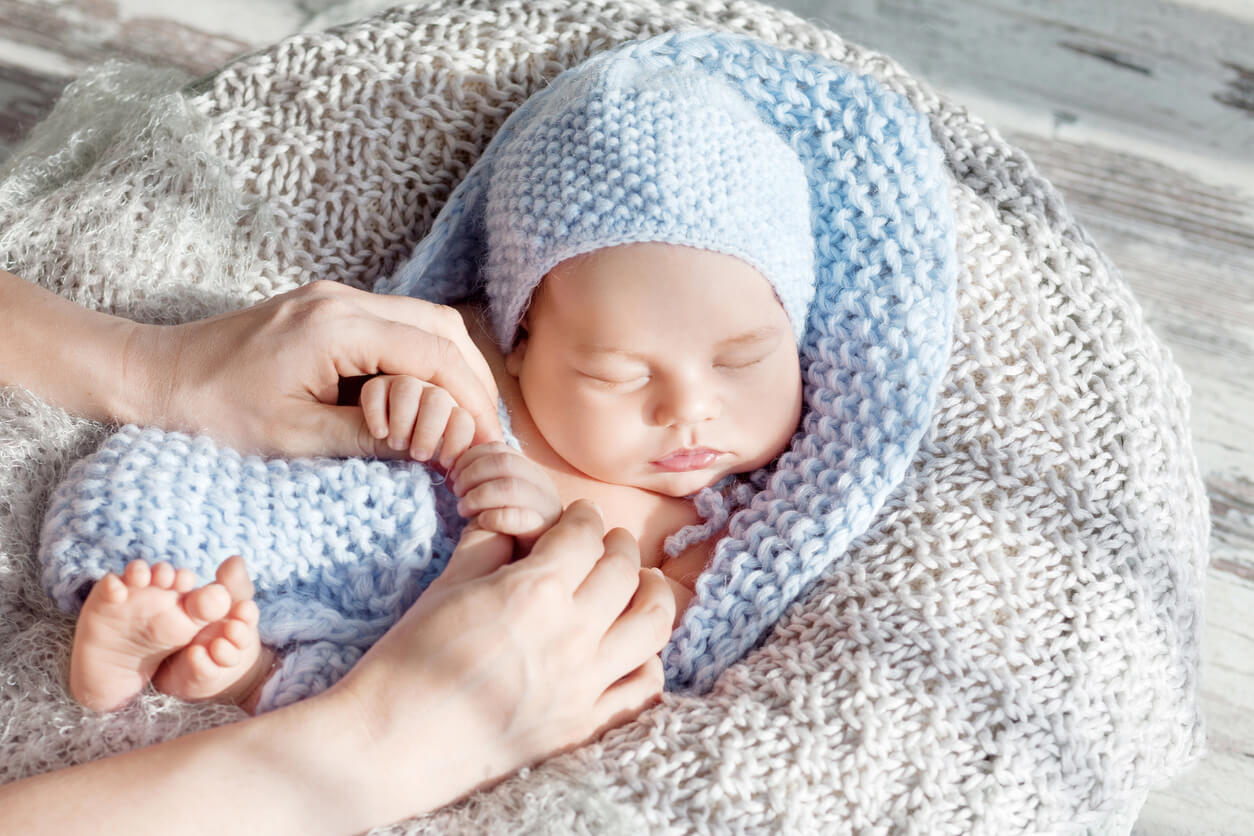Skin Color Changes in Newborns


Written and verified by the dermatologist Maria del Carmen Hernandez
Why do newborn skin color changes occur?
When a baby is born, skin color changes are closely related to the baby’s environment and health. These are conditions that can be normal unless they last too long.
Blue feet and hands
Acrocyanosis is a blue coloring of the feet and hands in newborns. After birth, this condition is common and is seen in the first few hours of life. This coloration is generated because oxygen and blood prioritize their circulation through other more important parts of the body, such as the lungs, brain, and kidneys, instead of irrigating the feet and hands.
As time goes by, the baby’s body gets used to the circulatory dynamics that it’ll have in the future. However, it can happen temporarily if, for example, the baby feels cold after a bath.

Purple lips and nails
Blue baby syndrome is a condition seen at birth or in the first few months of life. The main characteristic is a general purplish discoloration of the skin, called cyanosis. The most noticeable areas of cyanosis are those with the thinnest skin, such as the lips, nail beds, and earlobes. Cyanosis may appear all over the body or around the face or mouth.
Yellow skin
Jaundice is the yellowing of the skin or whites of the eyes. In most cases, the manifestation starts on the face and then spreads to the chest, lower abdomen, and legs. The yellowish coloration is generated because the body breaks down red blood cells, which is a normal process in newborns.
The product of this breakdown is bilirubin, which is metabolized by the liver and causes the yellow color. This pigmentation tends to disappear on its own. However, there are times when the newborn’s liver isn’t able to metabolize bilirubin fast enough.
Also read: Jaundice In Healthy Newborns
Pink or reddish skin
Newborns often have a light appearance or pinkish skin tone. This coloration is due to the blood vessels that are visible through the baby’s delicate, thin skin. This shade won’t be the final shade, but rather a greater amount of natural pigment will be produced to give color. In addition, newborns may have colored birthmarks, such as port wine stains.
You may be interested in: Angel Kisses and Stork Bites: Spots on Baby’s Skin
Pale skin
Babies at birth have an underdeveloped blood circulation system, so it’s common for different shades to emerge as a result. In fact, the microvasculature continues to evolve for about 4 months. In turn, babies have a lower concentration of melanin compared to adults in skin exposed to the sun’s rays.

When should I go to the doctor?
Some changes in the skin color of newborns may indicate a health problem and require medical attention. If the purplish hue doesn’t disappear after a crying spell, it may be a sign of an immature circulatory system or a respiratory problem. Also, if the baby has cyanosis of the lips, nails, and skin.
Heart defects cause cyanosis in babies because the oxygen levels in the blood are lower than they should be.
Newborn skin and its immaturity
Newborn skin tone changes as the baby matures and the baby’s immature blood circulation changes. They also have very thin skin and are sensitive to extreme temperatures. After the age of one year, the skin surface begins to fully mature and become functional and thicker and acts as natural insulation.
Why do newborn skin color changes occur?
When a baby is born, skin color changes are closely related to the baby’s environment and health. These are conditions that can be normal unless they last too long.
Blue feet and hands
Acrocyanosis is a blue coloring of the feet and hands in newborns. After birth, this condition is common and is seen in the first few hours of life. This coloration is generated because oxygen and blood prioritize their circulation through other more important parts of the body, such as the lungs, brain, and kidneys, instead of irrigating the feet and hands.
As time goes by, the baby’s body gets used to the circulatory dynamics that it’ll have in the future. However, it can happen temporarily if, for example, the baby feels cold after a bath.

Purple lips and nails
Blue baby syndrome is a condition seen at birth or in the first few months of life. The main characteristic is a general purplish discoloration of the skin, called cyanosis. The most noticeable areas of cyanosis are those with the thinnest skin, such as the lips, nail beds, and earlobes. Cyanosis may appear all over the body or around the face or mouth.
Yellow skin
Jaundice is the yellowing of the skin or whites of the eyes. In most cases, the manifestation starts on the face and then spreads to the chest, lower abdomen, and legs. The yellowish coloration is generated because the body breaks down red blood cells, which is a normal process in newborns.
The product of this breakdown is bilirubin, which is metabolized by the liver and causes the yellow color. This pigmentation tends to disappear on its own. However, there are times when the newborn’s liver isn’t able to metabolize bilirubin fast enough.
Also read: Jaundice In Healthy Newborns
Pink or reddish skin
Newborns often have a light appearance or pinkish skin tone. This coloration is due to the blood vessels that are visible through the baby’s delicate, thin skin. This shade won’t be the final shade, but rather a greater amount of natural pigment will be produced to give color. In addition, newborns may have colored birthmarks, such as port wine stains.
You may be interested in: Angel Kisses and Stork Bites: Spots on Baby’s Skin
Pale skin
Babies at birth have an underdeveloped blood circulation system, so it’s common for different shades to emerge as a result. In fact, the microvasculature continues to evolve for about 4 months. In turn, babies have a lower concentration of melanin compared to adults in skin exposed to the sun’s rays.

When should I go to the doctor?
Some changes in the skin color of newborns may indicate a health problem and require medical attention. If the purplish hue doesn’t disappear after a crying spell, it may be a sign of an immature circulatory system or a respiratory problem. Also, if the baby has cyanosis of the lips, nails, and skin.
Heart defects cause cyanosis in babies because the oxygen levels in the blood are lower than they should be.
Newborn skin and its immaturity
Newborn skin tone changes as the baby matures and the baby’s immature blood circulation changes. They also have very thin skin and are sensitive to extreme temperatures. After the age of one year, the skin surface begins to fully mature and become functional and thicker and acts as natural insulation.
All cited sources were thoroughly reviewed by our team to ensure their quality, reliability, currency, and validity. The bibliography of this article was considered reliable and of academic or scientific accuracy.
- Fluhr JW, Darlenski R, Taieb A, Hachem JP, Baudouin C, Msika P, De Belilovsky C, Berardesca E. Functional skin adaptation in infancy – almost complete but not fully competent. Exp Dermatol. 2010 Jun;19(6):483-92. doi: 10.1111/j.1600-0625.2009.01023.x. Epub 2010 Mar 23. PMID: 20353516.
- Steinhorn RH. Evaluación y manejo del neonato cianótico. Clin Pediatr Emerg Med . 2008; 9 (3): 169-175. doi: 10.1016 / j.cpem.2008.06.006
- Mitra S, Rennie J. Neonatal jaundice: aetiology, diagnosis and treatment. Br J Hosp Med (Lond). 2017 Dec 2;78(12):699-704. doi: 10.12968/hmed.2017.78.12.699. PMID: 29240507.
- Piazza J, Douin C, Bodson L, Ghuysen A, D’Orio V. Le cas clinique du mois. Syndrome du bébé bleu: la vérité cachée au fond du puits [Blue baby syndrome: the source of the truth]. Rev Med Liege. 2014 Apr;69(4):175-9. French. PMID: 24923096.
This text is provided for informational purposes only and does not replace consultation with a professional. If in doubt, consult your specialist.








